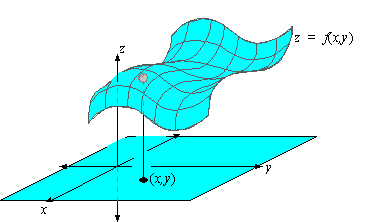
In the last chapter, we extended differential calculus to vector-valued functions. In this chapter, we extend calculus to functions of two variables, which are functions like f( x,y) = x2+y2 and g( x,y) = sin( x) cos( y) .
In particular, a function of 2 variables is a function whose inputs are points ( x,y) in the xy-plane and whose outputs real numbers. We often denote functions of 2 variables by f( x,y) , which means "the output from an input of ( x,y) ,'' and we often define these functions in the form
|
EXAMPLE 1 Evaluate f( 1,2) and f(2,5) if f( x,y) = x2+2xySolution: To begin with, f( 1,2) = 12+2·1·2 = 5, which is to say that f( x,y) = x2+2xy maps the point ( 1,2) to the number 5. Likewise, f(2,5) = 22+2·2·5 = 24.
The graph of f( x,y) is the set of points in R3 that satisfy z = f( x,y) . That is, the graph of f(x,y) is the surface z = f( x,y) and the output z is the height of the surface at the point ( x,y) .

A graphing calculator or computer algebra system is often used to produce an approximation of the graph of a function.
EXAMPLE 2 Use a computer algebra system to graph the function f( x,y) = x2+y2.Solution: If we let x be in [ -1,1] and if we let y be in [ -1,1] , then the result is the graph shown below:
However, if we choose the points ( x,y) to be in the circle of radius 1 centered at the origin, we obtain